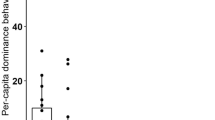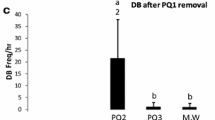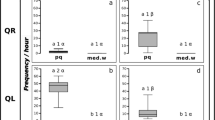Abstract
In many species of eusocial Hymenoptera, conflict about the production of males is resolved through “policing.” Recent studies in wasps and the ant Temnothorax unifasciatus suggest that in these species policing workers are dominant themselves and selfishly increase their own chances of later becoming fertile. Policing may therefore to some extent be associated with dominance and selfishness, and dominance and policing behaviour are indeed difficult to distinguish and often not mutually exclusive. Moreover, selfish policing requires that workers form rank orders already in the presence of the queen. Here, we try to allocate aggressiveness by workers towards policing and/or dominance behaviour and investigate whether hierarchies based on subtle, non-aggressive interactions exist in queenright colonies of the ant T. unifasciatus. We either split colonies into a queenright and queenless halve or temporarily removed the queen from complete colonies, which in both cases allows a few dominant workers to lay eggs in the queenless colony. Reunification of colony halves and return of the queen to orphaned colonies led to aggression against those workers that had become fertile during the absence of the queen. Dominant workers in reunited, split colonies were more severely attacked than those in orphaned colonies after return of the queen. Furthermore, we observed that workers, which later became dominant egg layers under queenless conditions, have more contact with the queen than other workers. Both results corroborate the existence of rank relationships among workers in queenright colonies and show that results from policing experiments may be affected by the disturbance of pre-existing hierarchies through colony splitting.





Similar content being viewed by others
References
Bourke A.F.G. 1988. Worker reproduction in the higher eusocial Hymenoptera. Q. Rev. Biol. 63: 291–311
Bourke A.F.G. 1991. Queen behavior, reproduction and egg cannibalism in multiple-queen colonies of the ant Leptothorax acervorum. Anim. Behav. 42: 295–310
Bourke A.F.G. 1994. Worker matricide in social bees and wasps. J. Theor. Biol. 167: 283–292
Buschinger A. 1974. Experimente und Beobachtung zur Gründung und Entwicklung neuer Sozietäten der sklavenhaltenden Ameise Harpagoxenus sublaevis (Nyl.). Insect. Soc. 21: 381–406
Buschinger A. and Alloway T.M. 1978. Caste polymorphism in Harpagoxenus canadensis M. R. Smith (Hym., Formicidae). Insect. Soc. 25: 339–350
Choe J.C. and Perlman D.L. 1997. Social conflict and cooperation among founding queens in ants. In: The Evolution of Social Behavior in Insects and Arachnids (Choe J.C. and Crespi B.J., Eds), Cambridge University Press, Cambridge, UK. pp 392–40
Cole B.J. 1981. Dominance hierarchies in Leptothorax ants. Science 212: 83–84
Cole B.J. 1986. The social behavior of Leptothorax allardycei (Hymenoptera, Formicidae): time budgets and the evolution of worker reproduction. Behav. Ecol. Sociobiol. 18: 165–173
Cuvillier-Hot V., Lenoir A., Crewe R., Malosse C. and Peeters C. 2004. Fertility signalling and reproductive skew in queenless ants. Anim. Behav. 68: 1209–1219
Endler A., Liebig J., Schmitt T., Parker J.E., Jones G.R., Schreier P. and Hölldobler B. 2004. Surface hydrocarbons of queen eggs regulate worker reproduction in a social insect. Proc. Natl. Acad. Sci. USA 101: 2945–2950
Faulkes C.G. and Bennett N.C. 2001. Family values: group dynamics and social control of reproduction in African mole-rats. Trends Ecol. Evol. 16: 184–190
Frank S.A. 1996. Policing and group cohesion when resources vary. Anim. Behav. 52: 1163–1169
Franks N.R. and Scovell E. 1983. Dominance and reproductive success among slave-making worker ants. Nature 304: 724–725
Hammer Ø., Harper D.A.T. and Ryan P.D. 2001. PAST: Paleontological statistics software package for education and data analysis. Palaeont. Electr. 4: 4
Hammond R.L. and Keller L. 2004. Conflict over male parentage in social insects. PLoS Biol. 2: e248
Hart A.G. and Monnin T. 2006. Conflict over the timing of breeder replacement in vertebrate and invertebrate societies. Insect. Soc. 53: 375–389
Hartmann A., Wantia J., Torres J.A. and Heinze J. 2003. Worker policing without genetic conflicts in a clonal ant. Proc. Natl. Acad. Sci. USA 100: 12836–12840
Heinze J. 1993. Queen–queen interactions in polygynous ants. In: Queen Number and Sociality in Insects (Keller L., Ed), Oxford University Press, Oxford. pp 334–361
Heinze J. 2004. Reproductive conflict in insect societies. Adv. Stud. Behav. 34: 1–57
Heinze J. 2008. Hierarchy length in orphaned colonies of the ant Temnothorax nylanderi. Naturwissenschaften 95: 757–760
Heinze J. and Smith T.A. 1990. Dominance and fertility in a functionally monogynous ant. Behav. Ecol. Sociobiol. 27: 1–10
Heinze J. and Ortius D. 1991. Social organization of Leptothorax acervorum from Alaska (Hymenoptera: Formicidae). Psyche 98: 227–240
Heinze J., Puchinger W. and Hölldobler B. 1997. Worker reproduction and social hierarchies in Leptothorax ants. Anim. Behav. 54: 849–864
Iwanishi S., Hasegawa E. and Ohkawara K. 2003. Worker oviposition and policing behaviour in the myrmicine ant Aphaenogaster smythiesi japonica Forel. Anim. Behav. 66: 513–519
Keller L. and Reeve H.K. 1994. Partitioning of reproduction. Trends Ecol. Evol. 9: 98–102
Kikuta N. and Tsuji K. 1999. Queen and worker policing in the monogynous and monandrous ant, Diacamma sp. Behav. Ecol. Sociobiol. 46: 180–189
Koedam D., Velthuis H.H.D., Dohmen M.R. and Imperatriz-Fonseca V.L. 2001. The behaviour of laying workers and the morphology and viability of their eggs in Melipona bicolor bicolor. Physiol. Entomol. 26: 254–259
Liebig J., Peeters C. and Hölldobler B. 1999. Worker policing limits the number of reproductives in a ponerine ant. Proc. R. Soc. Lond. B 266: 1865–1870
Liebig J., Monnin T. and Turillazzi S. 2005. Direct assessment of queen quality and lack of worker suppression in a paper wasp. Proc. R. Soc. Lond. B 272: 1339–1344
Michener C.D. and Brothers D.J. 1974. Were workers of eusocial Hymenoptera initially altruistic or oppressed? Proc. Natl. Acad. Sci. USA 71: 671–674
Monnin T. and Peeters C. 1997. Cannibalism of subordinates’ eggs in the monogynous queenless ant Dinoponera quadriceps. Naturwissenschaften 84: 499–502
Monnin T. and Ratnieks F.L.W. 2001. Policing in queenless ponerine ants. Behav. Ecol. Sociobiol. 50: 97–108
Nakata K. and Tsuji K. 1996. The effect of colony size on conflict over male-production between gamergate and dominant workers in the ponerine ant Diacamma sp. Ethol. Ecol. Evol. 8: 147–156
Ratnieks F.L.W. 1988. Reproductive harmony via mutual policing by workers in eusocial Hymenoptera. Am. Nat. 132: 217–236
Saigo T. and Tsuchida K. 2004. Queen and worker policing in monogynous and monandrous colonies of a primitively eusocial wasp. Proc. R. Soc. Lond. B 271: S509–S512
Strassmann J.E., Nguyen J.S., Arévalo E., Cervo R., Zacchi F., Turillazzi S. and Queller D.C. 2003. Worker interests and male production in Polistes gallicus, a Mediterranean social wasp. J. Evol. Biol. 16: 254–259
Stroeymeyt N., Brunner E. and Heinze J. 2007. “Selfish worker policing” controls reproduction in a Temnothorax ant. Behav. Ecol. Sociobiol. 61: 1449–1457
van Zweden J.S., Fürst M.A., Heinze J. and D’Ettorre P. 2007. Specialisation in policing behaviour among workers in the ant Pachycondyla inversa. Proc. R. Soc. Lond. B 274: 1421–1428
Wenseleers T., Tofilski A. and Ratnieks F.L.W. 2005. Queen and worker policing in the tree wasp Dolichovespula sylvestris. Behav. Ecol. Sociobiol. 58: 80–86
Wenseleers T. and Ratnieks F.L.W. 2006. Comparative analysis of worker reproduction and policing in eusocial Hymenoptera supports relatedness theory. Am. Nat. 168: E163–E179
Whitlock M.C. 2005. Combining probability from independent tests: the weighted Z-method is superior to Fisher’s approach. J. Evol. Biol. 18: 1368–1373
Wilson E.O. 1971. The Insect Societies. Belknap Press, Harvard University Press, Cambridge, MA. 548 pp
Acknowledgments
This work was supported by Deutsche Forschungsgemeinschaft (He 1623/17). Tina Wanke and Sabine Frohschammer kindly helped in the field. The experiments comply with the current laws of Germany.
Author information
Authors and Affiliations
Corresponding author
Rights and permissions
About this article
Cite this article
Brunner, E., Heinze, J. Worker dominance and policing in the ant Temnothorax unifasciatus . Insect. Soc. 56, 397–404 (2009). https://doi.org/10.1007/s00040-009-0037-x
Received:
Revised:
Accepted:
Published:
Issue Date:
DOI: https://doi.org/10.1007/s00040-009-0037-x




